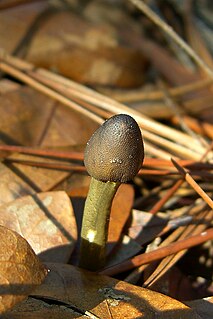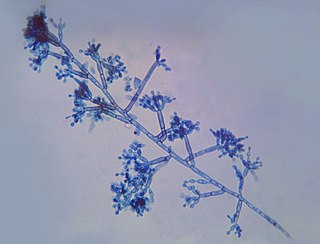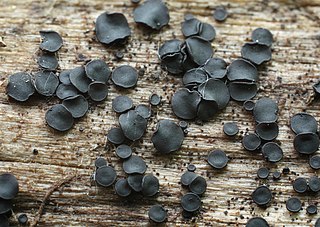
The Hypocreales are an order of fungi within the class Sordariomycetes. In 2008, it was estimated that it contained some 237 genera, and 2647 species in seven families. Since then, a considerable number of further taxa have been identified, including an additional family, the Stachybotryaceae. According to the Catalog of Life, As of April 2021 the Hypocreales contains 6 families, 137 genera, and 1411 species.

The order Sordariales is one of the most diverse taxonomic groups within the Sordariomycetes.

The Chaetothyriales are an order of ascomycetous fungi in the class Eurotiomycetes and within the subclass Chaetothyriomycetidae. The order was circumscribed in 1987 by mycologist Margaret Elizabeth Barr-Bigelow.

The Pyronemataceae are a family of fungi in the order Pezizales. It is the largest family of the Pezizales, encompassing 75 genera and approximately 500 species. Phylogenetic analyses does not support the prior classifications of this family, and suggest that the family is not monophyletic as it is currently circumscribed.

The Arthoniaceae are a family of lichenized, lichenicolous and saprobic fungi in the order Arthoniales. The Arthoniaceae is the largest family of Arthoniales, with around 800 species. Most species in Arthoniaceae belong in Arthonia which is the largest genus with 500 species. The second and third largest genus is Arthothelium with 80 species, and Cryptothecia with 60 species.
The Massarinaceae are a family of fungi in the order Pleosporales. Although taxa have a cosmopolitan distribution, they are better-known in temperate regions. They are thought to be saprobic in wood and bark; some species are weak pathogens.

The Ostropales are an order of fungi in the class Lecanoromycetes. The order was circumscribed by Swedish botanist John Axel Nannfeldt in 1932. The order contains 4 families and 46 genera, including 6 genera of uncertain familial placement.

The Stictidaceae are a family of fungi in the order Ostropales. The family was first described by Swedish mycologist Elias Magnus Fries in 1849.

Herpotrichiellaceae is a family of ascomycetous fungi within the order Chaetothyriales and within the class Eurotiomycetes. It contains 16 genera and about 270 species. The type genus of the family, Herpotrichiella, is now synonymous with Capronia.
Capronia is a genus of fungi in the family Herpotrichiellaceae. It has about 80 species.

The Trypetheliaceae are a family of mainly lichen-forming fungi in the order Trypetheliales.
The Schizothyriaceae are a family of fungi of uncertain ordinal placement in the class Dothideomycetes. It comprises 10 genera and around 70 species.
Thelocarpon is a genus of fungi in the family Thelocarpaceae.
Leptosillia is a fungal genus in the monogeneric family Leptosilliaceae. The genus was circumscribed by Austrian mycologist Franz Xaver Rudolf von Höhnel in 1928. The genus was monotypic for a long time, containing only the type species, Leptosillia notha. Molecular phylogenetic analysis published in 2019 showed that the genus belongs to the order Xylariales, and that the genus Cresporhaphis should be included in Leptosillia. These analyses placed Leptosillia as a sister taxon to family Delonicicolaceae, and so a new family, Leptosilliaceae, was circumscribed to contain it.

The Arctomiaceae are a family of lichenized fungi in the Ascomycota, class Baeomycetales. The family was named by Theodor Magnus Fries in 1861, with Arctomia as the type genus. Species in this family are found in arctic and subarctic habitats, usually associated with bryophytes.

Cordieritidaceae is a family of fungi in the order Cyttariales. Species in this family are saprobes or lichenicolous.

Patellaria is a genus of fungi in the family Patellariaceae. The genus was circumscribed in 1822 by mycologist Elias Magnus Fries with Patellaria atrata assigned as the type species.
Evan Benjamin Gareth Jones is a British mycologist. His main area of research interest is aquatic fungi, particularly marine fungi. He has supervised about 100 PhD and MSc students, published approximately 600 research articles and is a highly cited scientist. Other research interests include marine biofouling, biodeterioration of materials, and wood decay by fungi.










